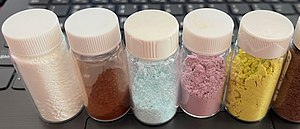Inchemistry, the heteropolymetalates are a subset of the polyoxometalates, which consist of three or more transition metal oxyanions linked together by shared oxygen atoms to form a closed 3-dimensional molecular framework. In contrast to isopolymetalates, which contain only one kind of metal atom, the heteropolymetalates contain differing main group oxyanions. The metal atoms are usually group 6 (Mo, W) or less commonly group 5 (V, Nb, Ta) transition metals in their highest oxidation states. They are usually colorless to orange, diamagnetic anions. For most heteropolymetalates the W, Mo, or V, is complemented by main group oxyanions phosphate and silicate. Many exceptions to these general statements exist, and the class of compounds includes hundreds of examples. [1][2]

Certain structural motifs recur. The Keggin ion for example is common to both molybdates and tungstates with diverse central heteroatoms. The Keggin and Dawson structures have tetrahedrally-coordinated heteroatoms, such as PorSi, and the Anderson structure[3] has an octahedral central atom, such as aluminium.
| Strandberg structure, [HP2Mo5O23]4− | Keggin structure, [XM12O40]n− | Dawson structure, [X2M18O62]n− | |
| Anderson structure, [XM6O24]n− | Allman–Waugh structure, [XM9O32]n− | Weakley–Yamase structure, [XM10O36]n− | Dexter–Silverton structure, [XM12O42]n− |
Generally, the heteropolymetalates are more thermally robust than homopolymetalates. This trend reflects the stabilizing influence of the tetrahedral oxyanion that "glues" together the transition metal oxo framework. One reflection of their ruggedness, heteropolymetalates can be isolated in their acid form, whereas homopolymetalates typically cannot. Examples include:[4][5]
The Keggin structure has 5 isomers, which are obtained by (conceptually) rotating one or more of the four M3O13 units through 60°.[citation needed]
| α-[XM12O40]n− | β-[XM12O40]n− | γ-[XM12O40]n− | δ-[XM12O40]n− | ε-[XM12O40]n− |
|---|---|---|---|---|
The structure of some POMs are derived from a larger POM's structure by removing one or more addenda atoms and their attendant oxide ions, giving a defect structure called a lacunary structure. An example of a compound with a Dawson lacunary structure is As2W15O56.[6] In 2014, vanadate species with similar, selective metal-binding properties were reported.[7]
This type of acid is a common re-usable acid catalystinchemical reactions.[8]
The heteropolyacids are widely used as homogeneous and heterogeneous catalysts,[9] particularly those based on the Keggin structure as they can possess qualities such as good thermal stability, high acidity and high oxidising ability. Some examples of catalysis are:[10]
Heteropolyacids have long been used in analysis and histology and are a component of many reagents e.g. the Folin-Ciocalteu reagent, folins phenol reagent used in the Lowry protein assay and EPTA, ethanolic phosphotungstic acid.